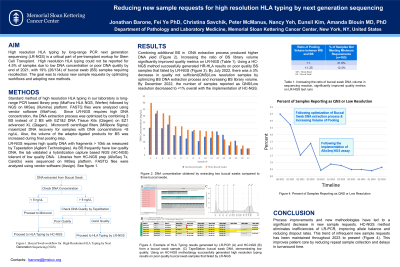Back

(P523) Reducing new sample requests for high resolution HLA typing by next generation sequencing
Location: Platinum Ballroom

Poster Presenter(s)
Aim: High resolution HLA typing (HR-HLA) by long-range PCR next generation sequencing (LR-NGS) is a critical part of pre-transplant workup for Stem cell transplant. HR-HLA could not be reported for 4.5% of samples due to poor DNA quality or low concentration by end of 2021, with 19% (26/134) of buccal swab (BS) samples requiring recollection. The goal was to reduce new sample requests by optimizing workflows and adopting new methods.
Method: Standard method of HR-HLA in our lab is long-range PCR based library prep (MiaFora HLA NGS, Werfen) followed by NGS on MiSeq (Illumina) platform. FASTQ files were analyzed using vendor software (MiaFora). Since LR-NGS requires high DNA concentration, the DNA extraction process was optimized by using 3 BS instead of 2 BS with EZ1&2 DNA Tissue Kits (Qiagen) on EZ1 advanced XL (Qiagen). Microcon® centrifugal filters (Millipore Sigma) maximized DNA recovery for samples with DNA concentrations <8 ng/uL. Also, the volume of the adaptor-ligated products for BS was increased during final pooling step. LR-NGS requires high quality DNA with fragments >10kb as measured by Tapestation (Agilent Technologies). As BS frequently have low quality DNA, the lab validated a hybridization capture based NGS (HC-NGS) tolerant of low quality DNA. Libraries from HC-NGS prep (AlloSeq Tx, CareDx) were sequenced on MiSeq platform. FASTQ files were analyzed using vendor software (Assign).
Results: Combining additional BS in DNA extraction process produced higher DNA yield (Figure 1). Increasing the ratio of BS library volume significantly improved quality metrics on LR-NGS (Table 1). Using a HC-NGS method successfully generated HR-HLA results on poor quality BS samples that failed by LR-NGS (Figure 2). By July 2022, there was a 3% decrease in quality not sufficient(QNS)/Low resolution results by optimizing BS DNA extraction and increasing BS library volume. By December 2022, the number of samples reported as QNS/Low resolution decreased to <1% overall with the implementation of HC-NGS.
Conclusion: Process improvements and new methodologies have led to a significant decrease in new sample requests. HC-NGS method eliminates inefficiencies of LR-PCR, improving allele balance and reducing dropout rates. This trend of infrequent new sample requests has been maintained throughout 2023 to present (Figure 3). This improves patient care by reducing repeat sample collection and delays in turnaround time.
Method: Standard method of HR-HLA in our lab is long-range PCR based library prep (MiaFora HLA NGS, Werfen) followed by NGS on MiSeq (Illumina) platform. FASTQ files were analyzed using vendor software (MiaFora). Since LR-NGS requires high DNA concentration, the DNA extraction process was optimized by using 3 BS instead of 2 BS with EZ1&2 DNA Tissue Kits (Qiagen) on EZ1 advanced XL (Qiagen). Microcon® centrifugal filters (Millipore Sigma) maximized DNA recovery for samples with DNA concentrations <8 ng/uL. Also, the volume of the adaptor-ligated products for BS was increased during final pooling step. LR-NGS requires high quality DNA with fragments >10kb as measured by Tapestation (Agilent Technologies). As BS frequently have low quality DNA, the lab validated a hybridization capture based NGS (HC-NGS) tolerant of low quality DNA. Libraries from HC-NGS prep (AlloSeq Tx, CareDx) were sequenced on MiSeq platform. FASTQ files were analyzed using vendor software (Assign).
Results: Combining additional BS in DNA extraction process produced higher DNA yield (Figure 1). Increasing the ratio of BS library volume significantly improved quality metrics on LR-NGS (Table 1). Using a HC-NGS method successfully generated HR-HLA results on poor quality BS samples that failed by LR-NGS (Figure 2). By July 2022, there was a 3% decrease in quality not sufficient(QNS)/Low resolution results by optimizing BS DNA extraction and increasing BS library volume. By December 2022, the number of samples reported as QNS/Low resolution decreased to <1% overall with the implementation of HC-NGS.
Conclusion: Process improvements and new methodologies have led to a significant decrease in new sample requests. HC-NGS method eliminates inefficiencies of LR-PCR, improving allele balance and reducing dropout rates. This trend of infrequent new sample requests has been maintained throughout 2023 to present (Figure 3). This improves patient care by reducing repeat sample collection and delays in turnaround time.

